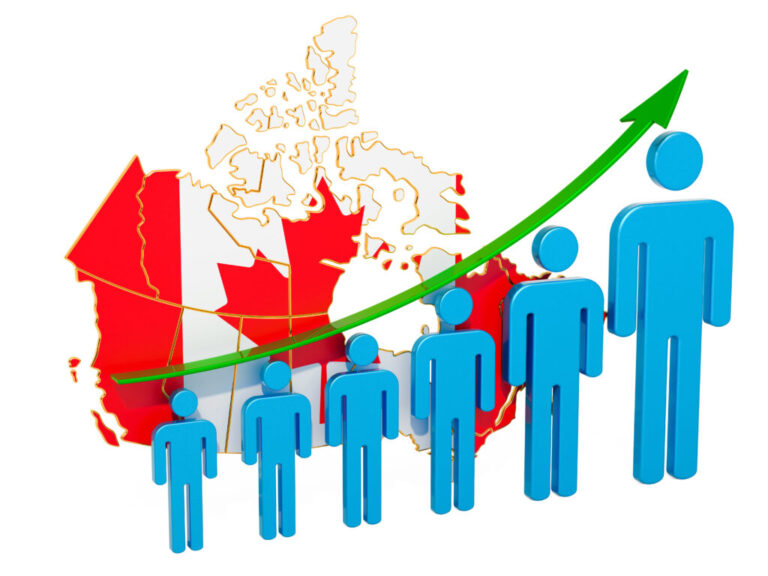As of July 1, 2024, Canada’s population trends reflect an ongoing concentration in urban areas, driven by international migration and sustained by the country’s growing census metropolitan areas (CMAs). With 74.8% of Canadians living in CMAs, an increase of 0.4 percentage points over the past year, these hubs remain the focal point for demographic change. At the same time, non-urban regions have seen growth at comparatively modest rates, underscoring the country’s increasing urbanization.
Strong Growth in CMAs Continues
Canada’s 41 CMAs reached a combined population of 30,893,239 on July 1, 2024, following a growth rate of 3.5% from the previous year. This marks the second consecutive year of over one million new residents in these urban centers. By contrast, census agglomerations (CAs)—smaller urban hubs—grew by 1.9%, while areas outside both CMAs and CAs experienced a minimal rise of 0.9%.
Toronto, Vancouver, and Montréal saw particularly noteworthy increases:
- Toronto CMA surpassed 7 million residents, hitting 7,106,379 after a record growth of 268,911 people (+3.9%).
- Vancouver CMA, growing at 4.2%, saw its population exceed the 3-million mark, reaching 3,108,941.
- Montréal CMA climbed to 4,615,154, reflecting growth of 132,000 people (+2.9%).
The rapid expansions in these regions were fueled primarily by increases in non-permanent residents (NPRs). Toronto led the way with a net gain of over 200,000 NPRs, while Montréal and Vancouver each added over 100,000. However, as data for the third quarter of 2024 shows, net NPR growth has begun to slow, with Ontario and Manitoba even recording declines in this category.

Source: Stats Canada
Impact of Migration Patterns
International migration remained the dominant driver of growth, accounting for almost all gains in large urban centers. Of the 464,265 immigrants arriving in Canada between July 2023 and July 2024, 46.7% settled in Toronto, Montréal, or Vancouver. However, these areas also experienced losses due to internal migration. Both interprovincial and intraprovincial migration resulted in negative net figures for the three largest CMAs:
Toronto saw a net loss of 69,522 residents within Ontario and an interprovincial deficit of 9,819.
Vancouver recorded interprovincial net losses of 5,709, the first since 2013, alongside intraprovincial losses of 15,193.
Montréal had net migration losses of 6,667 interprovincially and 21,901 intraprovincially.
Meanwhile, Alberta’s two largest CMAs—Calgary and Edmonton—experienced remarkable growth through interprovincial migration, gaining 20,859 and 13,893 residents, respectively, the highest net increases in over two decades.
Growth in Smaller Urban and Rural Areas
Although overshadowed by CMAs, other parts of Canada also witnessed notable demographic changes. CAs grew at their fastest annual rate in over 20 years (1.9%), with North Bay, Ontario, leading at 5.3% growth. In rural areas, interprovincial and intraprovincial migration played more significant roles, varying by province. For example, interprovincial migration was the top growth driver in Atlantic provinces, while intraprovincial migration was more influential in Quebec, Ontario, and British Columbia.
Slowing Trends
Population growth across Canada has generally slowed compared to the peaks of the last two years due to a decline in NPR increases during the second half of 2024. This shift, while modest, suggests that urban centers might experience more tempered growth moving forward.
According to Statistics Canada’s medium-growth scenario, the Canadian population, estimated at 40.3 million in 2024, is projected to experience a slight decrease from 2025 to 2026. This anticipated decline is attributed to a substantial reduction in the number of permanent residents admitted to the country, as well as a decrease in the number of non-permanent residents. However, in all projection scenarios, migratory increase remains the key driver of population growth in Canada, continuing a trend observed since the early 1990s.
It’s important to note that these projections are not predictions but are intended to explore possible future demographic changes based on current trends and assumptions.
